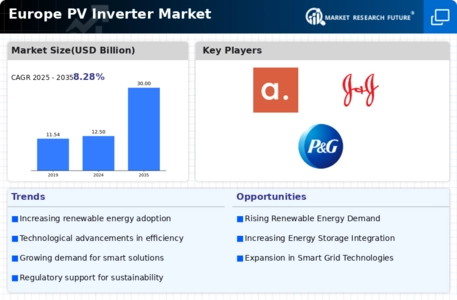Market Growth Projections
The Global Europe PV Inverter Market Industry is poised for substantial growth, with projections indicating a market size of 12.5 USD Billion in 2024 and an anticipated increase to 30 USD Billion by 2035. This growth trajectory suggests a robust expansion driven by various factors, including technological advancements, government support, and rising energy costs. The compound annual growth rate of 8.28% from 2025 to 2035 further underscores the market's potential. These figures reflect a dynamic landscape where photovoltaic inverters are becoming increasingly integral to the transition towards sustainable energy solutions.
Growing Demand for Renewable Energy
The increasing global emphasis on renewable energy sources drives the Global Europe PV Inverter Market Industry. As nations strive to meet climate goals and reduce carbon emissions, the adoption of solar energy systems is surging. In 2024, the market is projected to reach 12.5 USD Billion, reflecting a robust shift towards sustainable energy solutions. Governments across Europe are implementing policies and incentives to encourage solar energy deployment, further propelling the demand for photovoltaic inverters. This trend is expected to continue, with the market anticipated to expand significantly as more consumers and businesses invest in solar technology.
Government Incentives and Support Policies
Government incentives and support policies play a crucial role in shaping the Global Europe PV Inverter Market Industry. Various European countries are implementing favorable regulations and financial incentives to stimulate solar energy adoption. These measures include tax credits, feed-in tariffs, and grants for solar installations, which significantly lower the financial barriers for consumers and businesses. As a result, the market is experiencing accelerated growth, with a compound annual growth rate of 8.28% projected from 2025 to 2035. Such supportive frameworks are essential for fostering a conducive environment for the expansion of photovoltaic inverter technologies.
Rising Energy Costs and Energy Independence
The rising costs of traditional energy sources are prompting a shift towards solar energy, thereby influencing the Global Europe PV Inverter Market Industry. As energy prices continue to escalate, consumers and businesses are increasingly seeking alternative energy solutions to mitigate costs and enhance energy independence. This trend is particularly evident in Europe, where energy security concerns are driving investments in renewable technologies. The market's growth trajectory is expected to remain strong, with a projected size of 12.5 USD Billion in 2024, as more stakeholders recognize the long-term economic benefits of solar energy systems.
Increasing Adoption of Smart Grid Technologies
The increasing adoption of smart grid technologies is significantly impacting the Global Europe PV Inverter Market Industry. Smart grids facilitate better integration of renewable energy sources, including solar power, into the existing energy infrastructure. This integration enhances grid reliability and efficiency, making solar energy more viable for widespread use. As smart grid technologies evolve, they create new opportunities for photovoltaic inverter manufacturers to develop compatible products. The market is likely to benefit from this synergy, with a forecasted growth rate of 8.28% CAGR from 2025 to 2035, as the demand for intelligent energy management solutions rises.
Technological Advancements in Inverter Efficiency
Technological innovations in inverter efficiency are pivotal to the growth of the Global Europe PV Inverter Market Industry. Enhanced inverter technologies, such as string inverters and microinverters, are improving energy conversion rates and overall system performance. These advancements not only increase the energy yield from solar installations but also reduce the levelized cost of electricity. As a result, the market is likely to witness a surge in demand, with projections indicating a market size of 30 USD Billion by 2035. The continuous evolution of inverter technology is thus a critical driver, enabling more efficient and cost-effective solar energy solutions.













